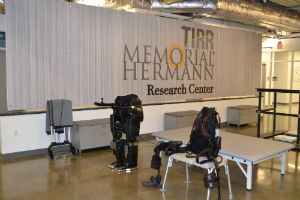
In addition to providing the very highest level of rehabilitation services to patients, TIRR Memorial Hermann has long been a leader in cutting-edge research to treat people with a range of disabilities and complex conditions such as brain and spinal cord injury, stroke, multiple trauma, amputation and neurodegenerative diseases.
The NeuroRecovery Research Center will house a number of labs conducting different studies and trials at the same time. The amount of collaboration that will go on among our teams is something that just can’t be beat,” says Dr. Gerard E. Francisco, chief medical officer at TIRR Memorial Hermann, director of NeuroRecovery Research Center and Professor and Chairman of Physical Medicine and Rehabilitation Department (PM&R) at McGovern Medical School at The University of Texas Health Science Center at Houston (UTHealth).
The NeuroRecovery Research Center is a collaborative project among clinicians, scientists and engineers. Currently TIRR Memorial Hermann is one of just 3 sites in the United States taking part in a clinical trial aimed at assessing Vagus Nerve Stimulation (VNS) during rehabilitation for improved upper limb motor function following a stroke.
TIRR Memorial Hermann is one of just a dozen sites in the United States participating in a unique stroke trial aimed at improving the quality of life for stroke survivors. Researchers use a non-invasive device capable of mapping the brain in order to deliver targeted magnetic stimulation that can suppress or enhance specific brain activity. Researchers are then able to determine the therapeutic effects of the navigated magnetic pulses for stroke rehabilitation.
It was important that our research building be connected to TIRR Memorial Hermann and the bridge is symbolic of how we want to do research,” says Dr. Francisco. “We do research to answer real world clinical questions so we can do better in our clinical care.”
Carl Josehart, Sr. Vice President and CEO, TIRR Memorial Hermann concurred.
This is an exciting time at TIRR as we take the research component of our rehabilitation services to the next level,” said Josehart. “This state-of-the-art facility will provide researchers with the tools to pioneer new advances in rehabilitative medicine and get our patients back to the life they love.